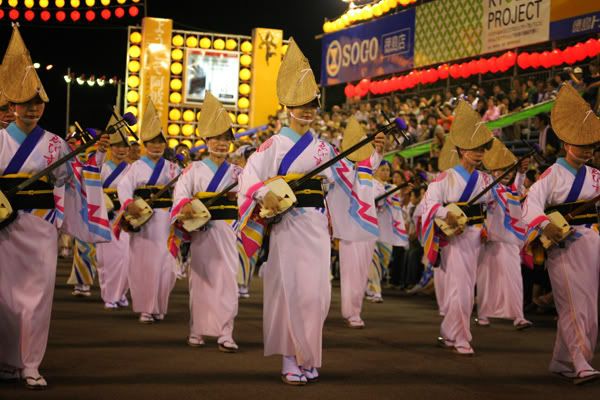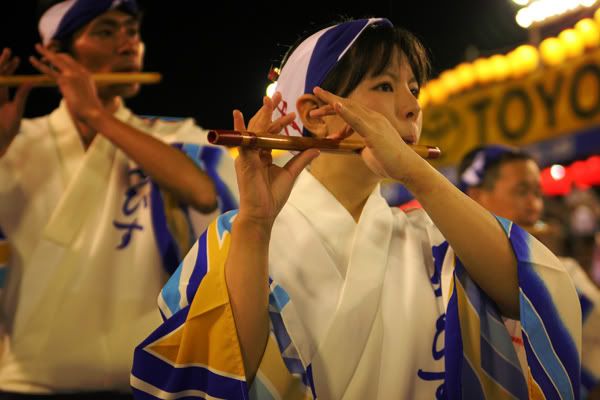Trip to Tokushima and...
...there was Awa-Odori, Tokushima's yearly dance festival. Somewhat "traditional" dance but it had a boozed up history. Held during the Obon festival every year and it is very packed up.
here is some info from Japanese National Tourist Organisation about the Awa Odori.
This Tokushima festival features folkdances performed to welcome the souls of ancestors in the Bon season, from July to August. It is well known throughout Japan for these words, which are voiced to set the rhythm, regardless of their meaning: 'It's a fool who dances and a fool who watches! If both are fools, you might as well have fun dancing!`. The dance dates back to 1587 when the feudal lord Hachisuka Iemasa (1558-1638), in celebration of newly-built Tokushima Castle, offered sake to the people of the castle town; the citizens became so drunk they started to dance in an unsteady gait. Awa is the former name of Tokushima. The Awa-Odori is characterized by irregular steps and by the jovial and energetic up-tempo rhythm. Separated into groups of men and women, the dancers parade through the city while dancing to music played on drums, gongs used when praying to Buddha and at festivals, three-stringed Japanese musical instruments, and flutes. The basic rule of this dance is to move your right arm forward with your right leg and your left arm forward with your left leg in turns to the two-beat rhythm.
The daytime attraction is the famous Selected Awa Dance by groups of several dozen dancers giving graceful performances on stage (admission charged). After 6 p.m., the town becomes enveloped in greater fervor. The excitement reaches fever-pitch by 10:30 p.m. in various parts of the city - parks in the city center, dance stages called enbujo where you can watch the dance up close, Odori Hiroba where even spectators sometimes join in the dancing, Odori Road linking the dance stages and Machikado Hiroba set up by neighborhood associations, as well as local shopping areas.
Here are some photos from the dance.




















here is some info from Japanese National Tourist Organisation about the Awa Odori.
This Tokushima festival features folkdances performed to welcome the souls of ancestors in the Bon season, from July to August. It is well known throughout Japan for these words, which are voiced to set the rhythm, regardless of their meaning: 'It's a fool who dances and a fool who watches! If both are fools, you might as well have fun dancing!`. The dance dates back to 1587 when the feudal lord Hachisuka Iemasa (1558-1638), in celebration of newly-built Tokushima Castle, offered sake to the people of the castle town; the citizens became so drunk they started to dance in an unsteady gait. Awa is the former name of Tokushima. The Awa-Odori is characterized by irregular steps and by the jovial and energetic up-tempo rhythm. Separated into groups of men and women, the dancers parade through the city while dancing to music played on drums, gongs used when praying to Buddha and at festivals, three-stringed Japanese musical instruments, and flutes. The basic rule of this dance is to move your right arm forward with your right leg and your left arm forward with your left leg in turns to the two-beat rhythm.
The daytime attraction is the famous Selected Awa Dance by groups of several dozen dancers giving graceful performances on stage (admission charged). After 6 p.m., the town becomes enveloped in greater fervor. The excitement reaches fever-pitch by 10:30 p.m. in various parts of the city - parks in the city center, dance stages called enbujo where you can watch the dance up close, Odori Hiroba where even spectators sometimes join in the dancing, Odori Road linking the dance stages and Machikado Hiroba set up by neighborhood associations, as well as local shopping areas.
Here are some photos from the dance.




















Comments